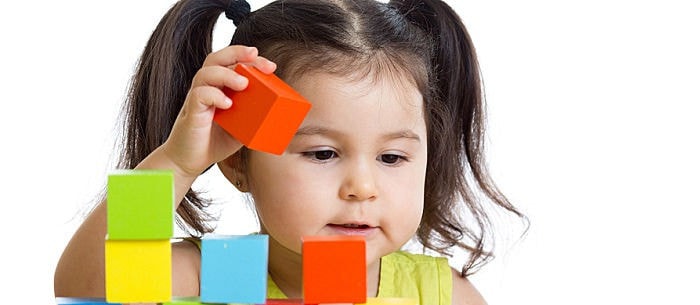Your little one is naturally interested in color. Those bright hues of blocks, balls and even snacks are a great opportunity to turn playtime (and snack time!) into a valuable learning experience. Playing color games with a little red, yellow and blue can help your kiddo learn some artsy concepts while hunting, tossing, matching — even eating.
It’s important for children to learn colors at an early age — as young as 2, according to the Centers for Disease Control. “Our world is in color and knowing which color is which is not just an art skill, but a life skill. Knowing the red stop sign or the green go sign is a basic need,” explains Emily Holtrop, the director of learning and interpretation at the Cincinnati Art Museum. Here are eight games to engage your youngster’s innate curiosity about colors:
- Sort Swatches
“Introduce your child to the world of shades and hues by giving her some paint swatches to explore,” says Maggie McGuire, vice president of Scholastic Parents Channel. You can snag these paper cards for free at paint and hardware stores. “She can sort them into different color piles, match similar colors and create a sequence ‘color train’ of hues from light to dark.” Bring out a glue stick and let your budding artist cut and paste the pieces of these color cards to make monochromatic collages.
- Play a Game of Fingertip Match Up
Use a washable marker to draw different colored dots on the fingertips of your toddler’s right hand. Draw the same dots on her left hand in a different order. Ask your child to try matching up the colors by touching her fingers together.
- Pair Colors With Snacks
This game is as delicious as it is educational. Draw a sketch of a monster, dinosaur or doll on a large sheet of paper, making spots on the body with different colored markers. Lay out colorful fruit snacks or candy-coated chocolates, and have the child match the treats to the colored circles. Game over? Now he can eat them for a snack.
- Go on a Color Hunt Outside
Call out a color and have your kids scatter and run toward something of that hue. They might find an orange leaf or a plastic swing in bright blue. Vary the game by asking the kids to point out the specific object you see. You might say, “I see a bright yellow flower that is the same color as the center of the traffic light. Can you find it? What else can you find that is yellow? Do you see someone wearing a yellow shirt?” says McGuire.
- Draw a Featherless Peacock
Draw the head and neck of the bird in the center of a paper plate, but only outline the tail feathers with dots of colors (use a different color for each feather). Give your child painted clothespins in varying hues and let her attach them to the plate, matching the correct colors to create a bright bird.
- Host a Light Show
Flashlights wrapped with colored cellophane make great tools for color games. Holtrop tells us to have the children shine them on a darkened wall and to even overlap two beams of primary colors to see what new colors the kids can create. Quiz them by asking them to create purple, orange or green.
- Have a Bean Bag Toss
Gather small, colorful bean bags (such as this Educational Insights Colors Bean Bags set) and paint inexpensive hula hoops to match each hue. For every bag your kid can toss into the matching hoop, your little one must shout out the color. If hula hoops are too bulky to store, use sheets of colored construction paper as the target instead.
- Use Beads or Building Blocks to Teach Patterns
Ask your little one to string plastic beads or stack Legos in a pattern. Start with something easy (such as red, yellow, red) before graduating to more complicated patterns. After instruction time is over, let your child make a pattern of her own.
Remember, games like these are about more than just learning blue, red and yellow. “All the basic skills of vocabulary, description, sorting, matching, observing and experimenting are inherent to color learning,” explains McGuire. Having fun is just an added bonus!
Want to help your little one learn the alphabet? Here’s a How-To Guide for Helping Kids Learn Their ABCs.
Tania K. Cowling is an author and freelance writer with a background in Early Childhood education and parenting.






